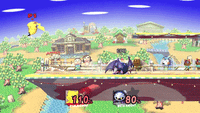Stage jump: Difference between revisions
No edit summary |
No edit summary |
||
| (17 intermediate revisions by 10 users not shown) | |||
| Line 1: | Line 1: | ||
{{articleIcons|unofficial=y|series=y}} | {{articleIcons|unofficial=y|series=y}} | ||
[[File:SSBB Stage Jump.gif|thumb|{{SSBB|Pikachu}} performing a stage jump under [[Smashville]] in a match against {{SSBB|Meta Knight}}.]] | [[File:SSBB Stage Jump.gif|thumb|{{SSBB|Pikachu}} performing a stage jump under [[Smashville]] in a match against {{SSBB|Meta Knight}}.]] | ||
A '''stage jump''' refers to the act of travelling under a [[stage]] with a character and returning on the other side | A '''stage jump''' refers to the act of travelling under a [[stage]] with a character and returning on the other side. They can be performed on any stage that has a large, hard platform and can be jumped under, such as on [[Smashville]] or [[Hyrule Temple]]. As the undersides of stages are long in distance and require the player to prevent themselves from crossing the lower [[blast line]], most stage jumps can only be performed by a small pool of characters that have long, varied recovery options, such as [[Jigglypuff]] or [[Meta Knight]]. The [[Temple jump]] is the most well-known stage jump in the series, due to every single character being able to perform it. | ||
Stage jumps can be performed in all games of the series, as all the installments have featured multiple stages that can accommodate the technique. They can be used to potentially surprise opponents while recovering, though many stage jumps can only be performed on stages that are not [[tournament legal]], such as [[Corneria]] or [[New Pork City]]. | |||
{{AllGames|Techniques}} | {{AllGames|Techniques}} | ||
Latest revision as of 10:01, November 10, 2018
A stage jump refers to the act of travelling under a stage with a character and returning on the other side. They can be performed on any stage that has a large, hard platform and can be jumped under, such as on Smashville or Hyrule Temple. As the undersides of stages are long in distance and require the player to prevent themselves from crossing the lower blast line, most stage jumps can only be performed by a small pool of characters that have long, varied recovery options, such as Jigglypuff or Meta Knight. The Temple jump is the most well-known stage jump in the series, due to every single character being able to perform it.
Stage jumps can be performed in all games of the series, as all the installments have featured multiple stages that can accommodate the technique. They can be used to potentially surprise opponents while recovering, though many stage jumps can only be performed on stages that are not tournament legal, such as Corneria or New Pork City.
